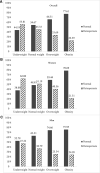Association of osteoporosis with sarcopenia and its components among community-dwelling older Chinese adults with different obesity levels: A cross-sectional study
- PMID: 38875436
- PMCID: PMC11175927
- DOI: 10.1097/MD.0000000000038396
Association of osteoporosis with sarcopenia and its components among community-dwelling older Chinese adults with different obesity levels: A cross-sectional study
Abstract
We aimed to investigate whether sarcopenia and its components are associated with osteoporosis in community-dwelling older Chinese adults with different obesity levels. This cross-sectional study included 1938 participants (42.1% male) with a mean age of 72.1 ± 5.9 years. The categorization of individuals into various weight categories was based on the Working Group on Obesity in China's criteria, utilizing the body mass index (BMI) as follows: underweight, BMI < 18.5 kg/m2; normal weight, 18.5 ≤ BMI < 24 kg/m2; overweight, 24 ≤ BMI < 28 kg/m2; and obesity, BMI ≥ 28 kg/m2. In this research, the osteoporosis definition put forth by the World Health Organization (bone mineral density T-score less than or equal to -2.5 as assessed by Dual-energy X-ray absorptiometry (DXA)). Sarcopenia was defined according to the diagnostic criteria of the Asian Working Group for Sarcopenia. The prevalence of osteoporosis was highest in the underweight group and gradually decreased with increasing BMI (Underweight: 55.81% vs Normal weight: 45.33% vs Overweight: 33.69% vs Obesity: 22.39). Sarcopenia was associated with elevated odds of osteoporosis in normal-weight subjects independent of potential covariates (OR = 1.70, 95% CI = 1.22-2.35, P = .002). In normal-weight participants, a higher appendicular skeletal muscle mass index (ASMI) was associated with a reduced risk of osteoporosis (OR = 0.56, 95% CI = 0.42-0.74, P < .001). In this study, we found that the prevalence of osteoporosis was highest in the underweight group and gradually decreased with increasing BMI. Sarcopenia, body fat percentage, and ASMI were associated with elevated odds of osteoporosis in normal-weight subjects independent of potential covariates, and higher percent body fat (PBF) was associated with an increased risk of osteoporosis in overweight people, and no such association was found in other weight groups. Different amounts of adipose tissue and muscle mass may alter bone biology. Further longitudinal follow-up studies are required to more accurately assess the risk of osteoporosis and sarcopenia in different weight populations. This cross-sectional study found that the prevalence of osteoporosis was highest in the underweight group and gradually decreased with increasing BMI. Sarcopenia was associated with elevated odds of osteoporosis in normal-weight subjects independent of potential covariates.
Copyright © 2024 the Author(s). Published by Wolters Kluwer Health, Inc.
Conflict of interest statement
The authors have no conflicts of interest to disclose.
Figures
Similar articles
-
Adipopenia is associated with osteoporosis in community-dwelling non-underweight adults independent of sarcopenia.Arch Osteoporos. 2023 Mar 22;18(1):44. doi: 10.1007/s11657-023-01233-x. Arch Osteoporos. 2023. PMID: 36949274
-
Prevalence of Sarcopenia in Community-Dwelling Chilean Elders According to an Adapted Version of the European Working Group on Sarcopenia in Older People (EWGSOP) Criteria.J Frailty Aging. 2017;6(1):12-17. doi: 10.14283/jfa.2016.117. J Frailty Aging. 2017. PMID: 28244552
-
The Prevalence Rate of Adult Sarcopenic Obesity and Correlation of Appendicular Skeletal Muscle Mass Index with Body Mass Index, Percent Body Fat, Waist-Hip Ratio, Basal Metabolic Rate, and Visceral Fat Area.Metab Syndr Relat Disord. 2023 Feb;21(1):48-56. doi: 10.1089/met.2022.0035. Epub 2022 Nov 1. Metab Syndr Relat Disord. 2023. PMID: 36318808
-
Osteoporosis and sarcopenia in older age.Bone. 2015 Nov;80:126-130. doi: 10.1016/j.bone.2015.04.016. Epub 2015 Apr 14. Bone. 2015. PMID: 25886902 Free PMC article. Review.
-
Is There Enough Evidence for Osteosarcopenic Obesity as a Distinct Entity? A Critical Literature Review.Calcif Tissue Int. 2019 Aug;105(2):109-124. doi: 10.1007/s00223-019-00561-w. Epub 2019 May 16. Calcif Tissue Int. 2019. PMID: 31098729 Review.
Cited by
-
Impact of vitamins A, D, and homocysteine on cardiometabolic multimorbidity in Northwest China.Nutr Metab (Lond). 2024 Aug 30;21(1):70. doi: 10.1186/s12986-024-00845-5. Nutr Metab (Lond). 2024. PMID: 39215279 Free PMC article.
References
-
- Cauley JA, Giangregorio L. Physical activity and skeletal health in adults. Lancet Diabetes Endocrinol. 2020;8:150–62. - PubMed
-
- Rosenberg IH. Sarcopenia: origins and clinical relevance. Clin Geriatr Med. 2011;27:337–9. - PubMed
-
- Evans AL, Paggiosi MA, Eastell R, Walsh JS. Bone density, microstructure and strength in obese and normal weight men and women in younger and older adulthood. J Bone Miner Res. 2015;30:920–8. - PubMed
MeSH terms
LinkOut - more resources
Full Text Sources
Medical



